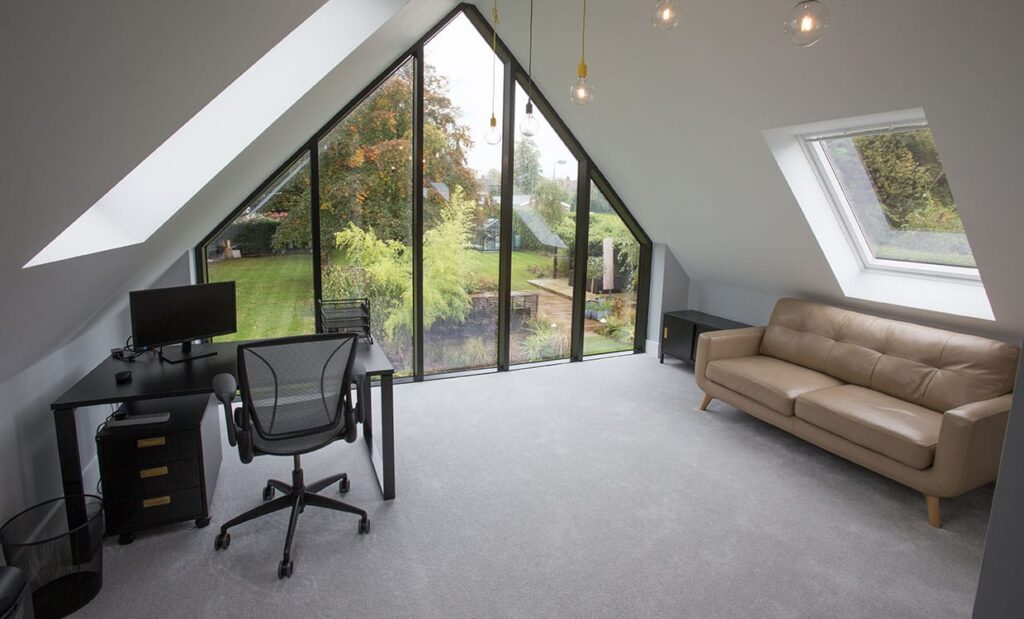Real Estate
From Vision Board to Reality: Tips for Achieving the Perfect Look in Your Home

Are you tired of imagining your dream home and never achieving it? Do you find yourself scrolling through Pinterest boards, longing for a picture-perfect living space? It’s time to turn that vision board into reality! In this blog post, we’ll take you through some tips and tricks to help achieve the perfect look in your home – from selecting the right color palette to nailing down decor styles. Get ready to transform your space into the ultimate sanctuary with our expert advice. Let’s get started!
Defining Your Aesthetic
Your home should reflect your personal style, so it’s important to have a clear understanding of your aesthetic before you start decorating. To get an idea of what you like, start by creating a vision board with images of rooms that inspire you. Once you have an idea of the overall look you’re going for, you can start narrowing down your choices for furniture, paint colors, and accessories.
If you’re having trouble defining your aesthetic, consider using a color palette as a starting point. You can either choose a few colors that you love and build from there, or use a pre-made palette as inspiration. Once you have your colors selected, it will be easier to shop for pieces that fit your vision.
Another way to narrow down your choices is to think about the specific details that you want in each room. For example, do you prefer modern or traditional furniture? Are you drawn to bold patterns or more subdued designs? Do you want lots of color or more neutral tones? By identifying the details that are most important to you, it will be easier to create a space that feels like home.
Creating a Mood Board
When it comes to creating a mood board for your home, there are a few things you should keep in mind. First, decide what feeling or overall look you want to achieve in your space. This will help you narrow down your search for inspiration. Once you have a general idea, start gathering images that reflect your vision. You can find these in magazines, online, or even create them yourself.
Once you have a good selection of images, it’s time to start putting them together. There are a few ways to do this, but the most important thing is to create a cohesive design. Start by arranging the images in a way that makes sense to you and then add in any final touches like colors or patterns that will help tie everything together.
With your mood board complete, it’s time to start making your vision a reality. Start with small changes and work your way up to bigger ones until your home is exactly the way you want it. And don’t forget, the most important thing is to have fun along the way!
Tips for Shopping for Furniture and Decor
There is no shortage of inspiration when it comes to home décor. Whether you are flipping through a magazine, scrolling through Pinterest, or even taking a walk through your neighborhood, it is easy to find ideas for how to style your own space. But translating that vision into reality can be a challenge. Here are a few tips for shopping for furniture and décor to help make your home dreams a reality:
1. Define your style. Before you start shopping, it is important to take some time to define your personal style. This will help you narrow down your options and make shopping easier and more efficient. Consider what styles you are drawn to and what elements you want to incorporate into your space.
2. Make a plan. Once you have an idea of your style, it is time to start planning out what pieces you need to purchase in order to achieve the look you want. Measure your space and create a floor plan or Mood Board with dimensions to help guide your shopping process. This will ensure that everything you buy fits perfectly in your space and comes together cohesively.
3. Set a budget. It is important to set a budget before shopping for furniture and décor so that you do not overspend on items that are not essential. Determine how much you are willing or able to spend on each item and stick to that number when making purchases. There is no need to break the bank in order to achieve the perfect look for your home –
How to Incorporate Your Vision into Your Home
Once you have your vision board complete, it’s time to start incorporating your vision into your home. Here are some tips to help you achieve the perfect look in your home:
1. Start with the basics. If you’re not sure where to start, begin with the basics – paint colors, furniture, and accessories. Once you have these items in place, you can start adding in other elements that will bring your vision to life.
2. Consider your color palette. When selecting paint colors and fabrics for your home, be sure to consider your overall color palette. This will help ensure that everything works together seamlessly and creates the desired look and feel.
3. add personal touches. Personalize your space by adding photos, artwork, and other personal touches that reflect your unique style and vision. These elements will make your space truly yours and help create a cohesive look throughout the entire house.
Conclusion
Vision boards can be an invaluable tool for achieving the perfect look in your home. Whether you’re looking to brighten up a drab space or create a more inviting atmosphere, these tips will help you get started on turning your vision board into reality. With careful planning, creativity and patience, you can transform any room into one that reflects your personal style and brings out the beauty of your home. So go ahead – make that dream come true!
Real Estate
Modern Lumber Skills Shaping High-Precision Material Planning

Introduction
In today’s construction and woodworking industries, precision is more important than ever. Modern lumber skills are transforming the way materials are planned, measured, and utilized. From small-scale woodworking projects to large construction sites, the ability to plan materials accurately reduces waste, saves costs, and ensures higher-quality results. High-precision material planning is no longer just a skill—it is a necessity for professionals who want to stay competitive. This article explores the role of modern lumber skills in shaping efficient, accurate, and innovative material planning practices.
The Evolution of Lumber Skills
Lumber skills have come a long way from traditional carpentry techniques. In the past, woodworkers relied heavily on manual measurements and experience to plan materials. While craftsmanship was impressive, there were limitations in accuracy and efficiency.
With modern techniques and technologies, the focus has shifted toward precision. Professionals now combine traditional knowledge with digital tools, advanced machinery, and innovative planning methods. These modern lumber skills allow for better estimation of material requirements, accurate cutting, and optimized project workflows.
Rise of Modern Lumber Skills
As the construction industry grows and projects become more complex, the demand for modern lumber skills has increased. Builders need more precise planning to manage materials efficiently and reduce waste. Traditional methods of estimating and cutting lumber are no longer enough. Modern skills, combined with technology and training, allow workers and contractors to plan materials accurately, making construction projects faster, safer, and more cost-effective. This rise in skill demand reflects the need for higher standards in today’s building practices.
Why High-Precision Material Planning Matters
High-precision material planning is essential for several reasons. First, it reduces waste. Accurate measurements mean fewer mistakes, fewer discarded materials, and a smaller environmental footprint. Second, it saves money. By planning materials efficiently, contractors and woodworkers minimize unnecessary purchases, reducing project costs. Third, it improves project timelines. Proper planning ensures that materials are available when needed, preventing delays.
In addition, precision planning enhances the final quality of the project. Structures, furniture, and wooden components fit perfectly, resulting in better aesthetics and durability. Modern lumber skills make this level of accuracy possible.
Benefits of Modern Lumber Skills
Modern lumber skills bring many benefits to construction projects. They help reduce waste by ensuring that materials are cut and used accurately. These skills also save time, as workers can plan and execute tasks more efficiently. Contractors can better predict costs, making budgeting easier and more reliable. Improved material planning also enhances project quality, as the right materials are available when needed. Overall, these skills lead to smoother workflows, lower costs, and stronger, more precise construction results.
Role of Modern Lumber Skills
The main role of modern lumber skills is to improve the accuracy and efficiency of material planning. Skilled workers use knowledge of wood types, cutting techniques, and measurement methods to plan projects carefully. They work with estimators and project managers to ensure the right materials are ordered and used correctly. Modern skills also involve using tools and software to calculate waste, compare cost options, and organize supplies. Essentially, these skills act as a bridge between planning and execution, helping construction teams achieve high-precision results.
The Importance of Precision in Lumber Work
High-precision material planning is not just for big factories. Even small woodworking projects benefit when measurements are accurate and planning is thorough. Precision helps in cutting the exact amount of wood needed, reducing leftover scraps and mistakes. Modern lumber skills teach how to measure carefully, select the right type of wood, and plan each step before starting a project. With these methods, craftsmen can avoid wasting expensive materials while also improving the quality of their work.
How Technology Supports Lumber Skills
Technology has played a huge role in modern woodworking. Tools like computer-aided design (CAD) software allow woodworkers to plan every cut and angle digitally before touching the wood. Laser measuring tools, digital calipers, and CNC machines make it easier to achieve exact measurements and shapes. These tools work hand-in-hand with traditional skills, allowing craftsmen to be faster, more accurate, and more efficient. Even beginners can now produce professional-level results with guidance from technology.
Reducing Waste Through Smart Planning
One of the biggest advantages of modern lumber skills is waste reduction. By planning projects carefully, woodworkers can use the full potential of each piece of wood. This not only saves money but also helps the environment by reducing discarded materials. High-precision planning ensures that even oddly shaped or smaller pieces of wood can be used creatively, turning what would be scraps into functional components of a project. Sustainable woodworking starts with smart planning and exact measurements.
Tools and Technologies Driving Modern Lumber Skills
Technology plays a critical role in modern lumber skills. Computer-aided design (CAD) software allows woodworkers to plan materials digitally, visualize projects, and simulate cuts before starting work. These tools help identify potential errors and optimize material usage.
Additionally, advanced machinery like CNC routers, laser cutters, and automated saws allow for precise cutting based on digital plans. These machines reduce human error and ensure consistent results across projects.
Mobile applications and project management software also support high-precision material planning by tracking inventory, estimating quantities, and scheduling deliveries. Together, these tools make modern lumber skills more efficient, accurate, and scalable.
Training and Skill Development

Image by: Yandex.com
Acquiring modern lumber skills requires a combination of education, hands-on experience, and familiarity with digital tools. Many vocational schools, technical programs, and workshops now offer training that combines traditional woodworking with technology-driven practices.
On-the-job training is equally important. Professionals learn how to interpret digital plans, operate advanced machinery, and make real-time adjustments to materials. Continuous skill development ensures that woodworkers remain competitive and capable of handling complex projects.
Real-World Applications
Modern lumber skills and high-precision material planning have applications in many industries. In residential construction, accurate planning reduces wasted wood and ensures that components like flooring, cabinetry, and furniture fit perfectly.
In commercial construction, precision is crucial for larger projects with tight timelines and budgets. Architects and contractors rely on detailed material plans to coordinate teams, schedule deliveries, and avoid costly mistakes.
Furniture making is another area where modern lumber skills shine. Precision cutting and planning allow designers to create intricate pieces with minimal waste, maintaining both quality and efficiency.
Environmental Benefits
High-precision material planning also supports sustainability. By reducing material waste, construction projects become more environmentally friendly. Fewer discarded materials mean less strain on landfills and lower resource consumption.
Modern lumber skills encourage recycling and repurposing leftover wood, further contributing to sustainable practices. Professionals who adopt these skills not only improve project efficiency but also demonstrate environmental responsibility, which is increasingly important to clients and communities.
Challenges in Adopting Modern Lumber Skills
Despite their importance, modern lumber skills come with challenges. Workers need proper training to use new tools and technologies effectively. Mistakes in measurement or planning can still occur, causing delays or added costs.
Coordinating with suppliers and adapting to material price changes can also be difficult. Additionally, some teams may resist adopting new methods, relying on older techniques instead. Overcoming these challenges requires continuous learning, clear communication, and careful supervision.While modern lumber skills offer significant advantages, adoption can present challenges. First, there is a learning curve associated with new technologies. Professionals must invest time and effort to become proficient with digital tools and advanced machinery.
Second, the cost of equipment can be high. CNC machines, laser cutters, and software licenses require substantial investment. However, the long-term benefits in efficiency, waste reduction, and project quality often outweigh initial costs. Finally, integrating modern practices into traditional workflows may require organizational changes. Teams need to adapt to digital planning methods and embrace new approaches to material management.
The Future of High-Precision Lumber Planning
The future of modern lumber skills looks promising as technology and training continue to evolve. Digital tools, software, and AI will make material planning faster and more precise. Workers will be able to simulate projects, predict costs, and reduce waste even further. As construction projects grow in complexity, these skills will become essential for achieving efficiency and quality. In the coming years, modern lumber skills will not only save time and money but also help builders meet higher standards of precision and sustainability.
The future of lumber skills and material planning is promising. Advancements in artificial intelligence, robotics, and automation are expected to further enhance precision and efficiency. AI-powered design tools could optimize material usage automatically, while robots and automated saws could perform complex cuts with minimal human intervention.
Sustainable practices will continue to grow in importance. Modern lumber skills will increasingly focus on maximizing material efficiency, minimizing waste, and supporting environmentally friendly construction. Professionals who adopt these practices will be better positioned for success in a competitive and evolving industry.
Conclusion
Modern lumber skills are transforming the way materials are planned, cut, and used across construction, woodworking, and design industries. By combining traditional craftsmanship with technology-driven tools, professionals can achieve high-precision material planning that reduces waste, saves money, and improves project quality.
The evolution from manual measurements to digital planning, CNC machinery, and AI-driven tools demonstrates how the industry is embracing efficiency and innovation. With proper training, investment in technology, and a focus on sustainability, modern lumber skills will continue to shape high-quality, cost-effective, and environmentally responsible projects for years to come.
For professionals and businesses, embracing these skills is not just a choice—it is a necessity to remain competitive, deliver superior results, and contribute to a sustainable future.
Business
Bespoke Loft Conversion and Design Services in the UK | Tacman

Introduction
Transform your unused attic space into a beautiful, functional area with expert Loft Conversion services from Tacman. Whether you need an extra bedroom, a home office, or a creative studio, a well-designed loft conversion adds both space and value to your property. At Tacman, we specialise in delivering bespoke loft conversions that blend innovative design, expert craftsmanship, and energy efficiency turning your vision into reality.
Loft conversions have become one of the most popular ways to expand living space in UK homes. Many homeowners are looking for smart, stylish, and functional solutions to add bedrooms, offices, or entertainment areas without moving house. Tacman specializes in bespoke loft conversion and design services, offering tailored solutions to meet every homeowner’s needs. With a focus on creativity, quality craftsmanship, and attention to detail, Tacman helps transform underused lofts into beautiful, practical living spaces. This guide will explore the benefits, process, and tips for choosing the right loft conversion service in the UK.
Why Choose a Bespoke Loft Conversion
A bespoke loft conversion offers unique advantages compared to standard or pre-designed options:
- Tailored to Your Needs: Every home is different, and a bespoke service ensures the loft is designed specifically for your lifestyle. Whether you need a home office, an extra bedroom, or a family lounge, the design can reflect your requirements.
- Maximizes Space Efficiently: A well-planned loft conversion makes the most of every inch, including awkward corners and sloped ceilings, turning wasted areas into functional space.
- Enhances Property Value: A professionally designed loft conversion can significantly increase the value of your property, making it a smart investment for the future.
- High-Quality Craftsmanship: Bespoke services focus on superior materials, attention to detail, and finishes that match the rest of your home, giving a polished and premium feel.
- Creative and Modern Designs: With bespoke design, you can integrate unique features like skylights, built-in storage, and stylish layouts that suit your taste and personality.
Popular Types of Loft Conversions in the UK
When considering a loft conversion, there are several popular types to choose from:
- Dormer Loft Conversion: This is the most common type, ideal for adding headroom and floor space. Dormers can be customized to match the home’s style.
- Mansard Loft Conversion: Mansard conversions involve altering the roof structure to create a nearly vertical wall. This allows for maximum space and is ideal for larger lofts.
- Hip-to-Gable Loft Conversion: Popular for semi-detached homes, this conversion extends the roof to create a spacious loft area.
- Velux or Roof-Light Loft Conversion: A simpler and more cost-effective option, Velux conversions use skylights to brighten the loft while retaining the existing roof structure.
- Bespoke Hybrid Designs: Tacman also offers hybrid solutions, combining features from different conversion styles to create unique, functional spaces tailored to individual homes.
Maximise Space and Add Value to Your Home
A loft conversion is one of the most cost-effective ways to expand your living space without the need for a full extension. Our design and build team work closely with you to plan, design, and construct a conversion that perfectly complements your home’s style and structure. From initial consultation to completion, we ensure that every stage is handled with care and precision.
We offer a variety of loft conversion types, including dormer, hip-to-gable, Velux, and mansard conversions each tailored to suit your specific property and requirements. Our architects and designers make the most of every inch, creating light-filled, practical spaces that improve your home’s functionality and aesthetic appeal.
Expert Design and Construction
At Tacman, we combine design excellence with high-quality construction standards to deliver loft conversions that stand the test of time. Using modern building materials, smart insulation solutions, and energy-efficient designs, we ensure your new loft space is comfortable and compliant with all UK Building Regulations.
Our experienced builders handle all structural work, plumbing, and electrical installations, giving you a fully finished space ready for use. From planning permission to the final touches, Tacman manages the entire process so you can enjoy a stress-free experience.
Tailored Solutions for Every Home
Every home is unique, and so is every loft conversion. That’s why we take a bespoke approach customising each project to meet your lifestyle, budget, and aesthetic preferences. Whether you live in a modern townhouse or a traditional cottage, our team designs conversions that enhance both the interior and exterior of your property.
We focus on detail, efficiency, and communication at every stage, ensuring our clients are fully informed and involved throughout the process. With our skilled design and construction team, you can trust Tacman to create a space that is both practical and inspiring.
Why Choose Tacman for Your Loft Conversion Project
Choosing the right company for your loft conversion is crucial to achieving lasting results. With Tacman, you get a team dedicated to delivering quality, transparency, and innovation. Our extensive experience in home design and construction means we understand how to maximise your property’s potential while maintaining structural integrity and aesthetic value.
At Tacman, we’re passionate about helping homeowners transform unused spaces into comfortable, modern living areas. From concept to completion, we’re your trusted partner in creating loft conversions that elevate both lifestyle and property value.
The Loft Conversion Process
A professional loft conversion service like Tacman follows a structured process to ensure high-quality results:
- Initial Consultation: The process begins with a detailed consultation to understand your requirements, budget, and vision for the space.
- Design and Planning: Designers create a bespoke plan, including layout, materials, lighting, and storage solutions, while considering the structural aspects of your home.
- Planning Permission and Regulations: Tacman handles all planning applications, building regulations, and necessary approvals to ensure the conversion meets UK standards.
- Construction and Project Management: Experienced builders work efficiently to execute the design while minimizing disruption to your daily life. Project managers oversee timelines, materials, and workmanship.
- Finishing Touches: High-quality finishes, custom joinery, lighting, and décor are added to create a functional and aesthetically pleasing living space.
- Handover and Aftercare: The completed loft is handed over to the homeowner with guidance on maintenance and support for any post-construction questions.
Benefits of a Tacman Bespoke Loft Conversion
Choosing Tacman for your loft conversion comes with several key advantages:
- Custom Designs tailored to your lifestyle and property.
- Expert Craftsmanship ensuring durability and premium quality.
- Efficient Project Management to keep timelines and budgets on track.
- Compliance with UK Building Regulations to guarantee safety and legality.
- Creative Solutions to make the most of space, light, and aesthetics.
Tips for Planning Your Loft Conversion
Before starting your loft conversion, consider the following:
- Set a Realistic Budget: Factor in design, construction, planning permissions, and finishing costs to avoid surprises.
- Think About Purpose: Decide whether the loft will be a bedroom, office, gym, or multifunctional space to guide the design.
- Maximize Natural Light: Skylights, dormers, and roof windows can make the loft feel more open and welcoming.
- Consider Storage Solutions: Built-in wardrobes, shelves, and under-eaves storage make the most of available space.
- Hire a Trusted Professional: Working with experienced professionals ensures quality design, construction, and regulatory compliance.
Popular Features in Modern Loft Conversions
Modern loft conversions often include features to enhance comfort, functionality, and style:
- Skylights or roof windows for natural light.
- Built-in storage to maximize space efficiency.
- Custom staircases to connect the loft seamlessly with the rest of the home.
- Modern insulation and ventilation to improve energy efficiency.
- Stylish lighting and décor elements to match the home’s aesthetic.
Conclusion
Bespoke loft conversion and design services in the UK offer homeowners the perfect solution to expand living space without moving. Tacman specializes in creating tailored, high-quality loft conversions that blend style, functionality, and comfort. From dormers to Mansard conversions and creative hybrid designs, every project is crafted to meet individual needs while enhancing property value. By choosing a professional service, you can ensure that your loft is transformed into a beautiful, practical, and valuable addition to your home. With careful planning, expert guidance, and attention to detail, a bespoke loft conversion is a smart investment for the present and the future.
Real Estate
Property in Pune: Your Complete Guide to Buying the Best Homes

Introduction
Pune has grown into one of India’s most dynamic cities, attracting homebuyers and investors from across the country. Known for its pleasant climate, modern infrastructure, and booming IT and education sectors, the demand for property in Pune has risen steadily over the years. Whether you’re looking for a residential apartment, a luxury flat, or commercial property, Pune offers a perfect mix of lifestyle and investment opportunities.
At Properties Dekho, we bring you verified listings of property in Pune for sale to help you make confident and informed decisions. From affordable 1 BHK homes to premium 4 BHK apartments, our platform covers every segment of Pune’s thriving real estate market.
Why Choose Pune for Real Estate Investment
When it comes to stability and long-term value, few cities match Pune’s potential. The city combines modern living with a balanced lifestyle, making it ideal for both working professionals and families. If you’re planning to buy property in Pune, here’s why it’s one of the best choices you can make:
- IT and Industrial Growth: Pune’s booming IT corridor in Hinjewadi, Kharadi, and Magarpatta has created huge housing demand.
- Educational Excellence: Renowned institutions attract students and families, ensuring consistent rental returns and property appreciation.
- Quality Infrastructure: Smooth roads, metro connectivity, and green surroundings make it one of the most liveable cities in India.
- High ROI Locations: The property rates in Pune continue to appreciate across all major localities, offering great returns on investment.
These factors have transformed Pune from a peaceful city into a thriving metropolitan hub for real estate investment.
Buy Property in Pune: Options for Every Lifestyle
The Pune property market caters to everyone from first-time buyers to luxury seekers. Whether you want a modern apartment, a villa, or a commercial office space, you’ll find plenty of property in Pune for sale that fits your budget and lifestyle.
- Affordable Apartments: Ideal for small families or individuals who want a comfortable home at a reasonable price.
- Luxury Homes: Premium flats and penthouses in areas like Baner, Kalyani Nagar, and Koregaon Park offer top-notch amenities and style.
- Villas & Row Houses: Spacious living options in areas like Wagholi and Hadapsar combine peace with accessibility.
- Commercial Properties: Ideal for startups and established businesses looking for office space in Pune’s fast-developing zones.
Understanding Property Rates in Pune
Before you invest, it’s important to understand property rates in Pune. Prices vary widely depending on the location, infrastructure, and project type. Premium areas like Kharadi, Baner, and Aundh command higher prices, while developing localities such as Wagholi, Hinjewadi, and Hadapsar offer affordable options.
In the last few years, Pune’s real estate market has shown steady price appreciation due to rising employment opportunities and infrastructure growth. The metro expansion and road connectivity projects have further boosted the value of property in Pune for sale, making now a great time to invest.
Top Localities to Buy Property in Pune
Choosing the right location is key to a successful investment. Some of the most preferred areas for buying property in Pune include:
- Hinjewadi: The IT hub of Pune with numerous new housing projects and great connectivity.
- Kharadi: A rapidly developing area known for modern living and proximity to EON IT Park.
- Baner: Offers premium lifestyle amenities, great road access, and strong appreciation value.
- Hadapsar: Affordable and well-connected, perfect for first-time buyers.
- Wakad: Popular among families for its schools, shopping centers, and easy access to the Mumbai-Pune Expressway.
- Koregaon Park: A symbol of luxury living and elite lifestyle in Pune.
These localities offer everything a modern homebuyer looks for—convenience, safety, and value growth.
Buy Property in Pune with Properties Dekho
At Properties Dekho, our mission is to make your home-buying journey effortless and rewarding. We list genuine and verified properties across Pune to help you find your dream home without stress.
Why Choose Us:
- 100% verified property listings.
- Real-time updates on property rates in Pune.
- Expert consultation and property comparisons.
- Assistance with site visits, paperwork, and financing.
- Wide range of properties – from affordable flats to luxury villas.
Our platform makes it easy to browse, compare, and buy property in Pune that suits your lifestyle and budget.
Future of Real Estate in Pune
The future of Pune’s real estate market looks promising. With ongoing development projects, rising employment, and improved infrastructure, property rates in Pune are expected to continue increasing. Investors are showing growing interest in Pune’s outskirts such as Wagholi, Ravet, and Tathawade, which offer modern projects at affordable prices.
The city’s growing tech industry ensures consistent demand for property in Pune for sale, making it a smart long-term investment for both residents and non-resident Indians (NRIs).
Conclusion
Pune is more than just a city it’s a lifestyle destination where modern living meets peace and opportunity. Whether you’re planning to buy property in Pune for personal use or investment, the city offers unmatched potential and comfort.
Also Read: construction company in Lahore
-
Business2 years ago
Cybersecurity Consulting Company SequelNet Provides Critical IT Support Services to Medical Billing Firm, Medical Optimum
-
Business2 years ago
Team Communication Software Transforms Operations at Finance Innovate
-
Business2 years ago
Project Management Tool Transforms Long Island Business
-
Business2 years ago
How Alleviate Poverty Utilized IPPBX’s All-in-One Solution to Transform Lives in New York City
-
health2 years ago
Breast Cancer: The Imperative Role of Mammograms in Screening and Early Detection
-
Sports2 years ago
Unstoppable Collaboration: D.C.’s Citi Open and Silicon Valley Classic Unite to Propel Women’s Tennis to New Heights
-
Art /Entertainment3 years ago
Embracing Renewal: Sizdabedar Celebrations Unite Iranians in New York’s Eisenhower Park
-
Finance3 years ago
The Benefits of Starting a Side Hustle for Financial Freedom































